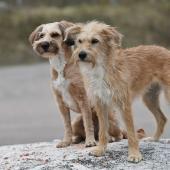What?
Cross breeding is a tool for breeding. It aims to save dog breeds that are in danger of extinction or becoming impossible in their illnesses and low genetic diversity.
In cross breeding, two different dog breeds are crossbred systematically and under control. The breeds may not necessarily have any previous history together. The breed that is going to be crossbred, needs health and traits which are sought from another breed that would offer them best. Reining in well-being issues caused by extreme qualities, and correcting harmful gene mutations attached to certain breeds, is not possible without a broader breeding base.
In the history of dog breeding, cross breeding has been generally used for at least over two hundred years. Almost all contemporary breeds have been developed by cross breeding.
In Finland, systematic cross breeding, approved by the Finnish Kennel Club, has been done since 1997. The first cross breeding project was to breed two variations of what was originally one breed: the Pincher and the Schnauzer. The results were good and the vitality and desired characteristics of the Pincher, that had been sidelined by its cousin, increased.
Cross breeding projects take a lot of work and require careful planning and follow-up. And such a project is never begun unless there is a proper need. Altogether, there have been or are ongoing at the moment 10 official cross breeding projects in Finland.
Why?
If the breed does not have enough of a healthy population, it is necessary to make a decision, which at first sounds radical, to cross breed with another healthy breed.
The purpose of cross breeding is to improve the dog breed that is in trouble because of its traits or health situation. If a breed is small or there is not enough variety in its genetics to selectively breed to acquire traits that influence the dogs’ well-being, help may be found from another breed. Cross breeding is meant to create diversity and broaden the genetics of the original breed so that it can remain healthy and vital.
If a dog breed has bad traits or hereditary diseases, it is possible to reduce or eliminate these through cross breeding. Cross breeding might also restore valuable traits that have decreased over time.
Cross breeding is a way of preventing a dog breed from extinction or impossibility to survive. For example, an ancient Norwegian Lundehund has recently been saved through cross breeding, when health issues threatening for the breed’s well-being multiplied in the existing population. At the same time, the breed’s genetics were improved.
In some countries, a decision has been made to ban a certain breed; for example, in Norway, breeding of the Cavalier King Charles Spaniel was banned for health reasons. In Finland, the aim is to do all that can be done to avoid banning breeds.
How?
The idea of cross breeding is that selected individuals from another breed will bring health and desired characteristics into the crossbred breed.
The purpose of cross breeding is not to crossbreed the whole breed but to selectively introduce diversity and healthy genetics into the breed. Fear of corrupting the breed by cross breeding is unnecessary. The amount of cross breeding is kept high enough to introduce benefits to the breed but small enough that the new genetics will not take over. Most of the breed cannot be crossbred offspring because the recommendation for the maximum amount of crossbred offspring is only 2–5 per cent of the registered dogs during a four-year time period. Each instance of cross breeding is a kind of experiment in which the offspring are carefully evaluated and the question of continuing is then decided.
It is worth remembering that participation in cross breeding is entirely voluntary. Breeding of the breed in question will mainly continue as before. Only some carefully selected individuals are crossbred with healthy individuals that have a suitable character from another breed. This requires a long-term commitment from both the breeders in the project and the buyers of crossbred puppies, because the crossbred offspring’s health and characteristics are followed throughout their lives.
It is also notable that the external breed used in cross breeding only serves to introduce positive characteristics. All crossbred offspring are always registered as the original breed.
The aim of cross breeding is to help and improve the situation of the breed over the long term. That is why cross breeding plans cover multiple generations. A proposal for cross breeding comes from a breed club or organisation, not from an individual breeder. Ultimately, the Finnish Kennel Club approves a well-argued plan.
Frequently asked questions
Learn the breed terminology
A Pedigree Dog = An individual born as a result of dog breeding that began in Britain already in the 19th century. There are almost 350 recognised dog breeds in Finland. For example, the history, pedigree, breed standards, character description and purpose are known for the breeds.
A Cross Breeding Project = Carefully considered and analysed project in which the goal is to improve the characteristics and increase the genetic variety of a breed. The Finnish Kennel Club approves a cross breeding project that a breed club or organisation undertakes together with the breeders.
A Crossbred Dog = The registered offspring of two different breeds that has been planned systematically and under control, and the life of which is followed with the help of comprehensive health studies and character analysis. For this reason, official crossbred dogs are never sold in Tori, for example. Puppies born as a result of cross breeding are registered in the ER register, or puppies from projects approved after the 1 January 2024 will be registered in a new cross breed register.
A Breed Mix = Usually two different breeds are mixed randomly and there is no intention to improve either of the breeds. For example, a Labradoodle, a mix of a Labrador Retriever and a Poodle, is not an official breed designed to improve either of the original breeds’ health or characteristics. The puppies are not registered as either of the original breeds, but they will be unregistered crossbred puppies which can be recorded in the Finnish Kennel Club’s dog identification marking register.
A Mixed or Multi Breed = A mixed breed puppy may be a result of a coincidence, a crossbreed cannot. A mixed breed dog may have a background of multiple different breeds, and the dog does not have an official pedigree. These dogs can be registered in the identification marking register.
A Trendy Breed = A breed that suddenly becomes popular because of a television show or a famous dog owner, for example. The sudden popularity of a breed may sometimes backfire on fast breeding where the breed’s character and health issues are not taken care of.
Design Breed = A crossbreed that has been made by consciously mixing two breeds and which has been given an artificial “breed name” like Cavadoodle or Cockapoo. Buyers’ likes may inspire these kinds of independent experiments which are not part of official cross breeding.
Further information on cross breeding:
Cross breeding offers help in dog breeding video (in Finnish)
Breed bans are not the best way to go when improving the health and well-being of dogs







 Hau-Hau Champion
Hau-Hau Champion Agria
Agria